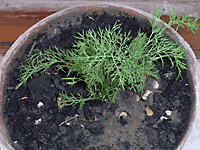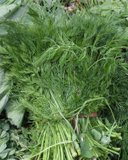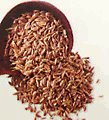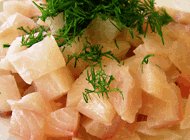Dill weed (herb) nutrition facts
Dill weed is a unique perennial herb with a pleasant anise-like flavor. Its sprigs (leaves), as well as seeds, are employed as a seasoning in various cuisines worldwide. Dill is a member of the Umbelliferae family, a large group of flowering herbs and spices that also includes caraway, parsley, cumin, fennel, etc.
Botanically, dill belongs to the family of Apiaceae, in the genus: Anethum, and scientifically named Anethum graveolens.

|

|
| Dill herb (Anethum graveolens). | Dill sprigs (close-up). Note slender wisp and fern like dill sprigs. |
Dill is native to Mediterranean and Eastern-European regions. Just like in cilantro, it too requires warm summer climates with well-drained fertile soil to flourish. It grows 1 to 2 feet in height and features dark-green leaves (sprigs) that are wispy and fernlike, have a soft texture with a rich, pleasant anise aroma and sweet taste.
Dill seeds, used as condiment spice, are similar in taste and appearance to "caraway seeds." They feature light brown color, oval shape with vertical ridges, and flavor that is aromatic, sweet, and citrus, but also slight bitterly.
Health benefits of dill
Dill weed contains many plant-derived chemical compounds that are known to have anti-oxidant, disease-preventing, and health-promoting properties.
This popular herb does not contain cholesterol and is very low in calories. Nonetheless, it holds many antioxidants, vitamins like niacin, pyridoxine, etc., and dietary fibers, which help in controlling blood cholesterol levels.
Dill leaves (sprigs) and seeds carry many essential volatile oils such as d-carvone, dillapiole, DHC, eugenol, limonene, terpinene, and myristicin.
The essential oil, Eugenol in the dill has been in therapeutic usage as a local anesthetic and antiseptic. Eugenol has also been found to reduce blood sugar levels in people with diabetes. (Further detailed studies, however, are required to establish its role.)
Dill oil, extracted from dill seeds has anti-spasmodic, carminative, digestive, disinfectant, galactagogue (helps breast milk secretion), and sedative properties.
It is also rich in many vital vitamins, including folic acid, riboflavin, niacin, vitamin-A, ß-carotene, vitamin-C that is essential for optimum metabolism inside the human body.
Vitamin-A and β- carotene are natural flavonoid antioxidants.
100 g of dill weed sprigs provide 7718 IU or 257% of daily recommended levels of this vitamin. Vitamin A is also required for maintaining healthy mucosa and skin and is essential for good vision. Consumption of natural foods rich in flavonoids helps the human body to protect from lung and oral cavity cancers.
Fresh dill herb is an excellent source of antioxidant vitamin, vitamin-C. 100 g contains about 85 mg or 140% of vitamin C. Vitamin C helps the human body develop resistance against infectious agents and scavenge harmful, pro-inflammatory free radicals.
Dill weed is a good source of minerals like copper, potassium, calcium, manganese, iron, and magnesium. Copper is a cofactor for many vital enzymes, including cytochrome c-oxidase and superoxide dismutase (other minerals that function as cofactors for this enzyme are manganese and zinc). Zinc is a co-factor in many enzymes that regulate growth and development, digestion, and nucleic acid synthesis. Potassium is an important component of cells and body fluids that helps control heart rate and blood pressure. The human body uses manganese as a co-factor for the antioxidant enzyme, superoxide dismutase.
Dill herb has all the characteristics to consider it one of the most valued functional foods. 100 g of dill weed provides only 43 calories, but its phytonutrient profile is no less than any other high-calorie food source; be it nuts, pulses, cereals, or meat group.
100 g fo this herb provides (%of RDA per 100 g):
37.5% of folates (vitamin B11),14% of vitamin B-6 (pyridoxine),
23% of riboflavin (vitamin B-2),
140% of vitamin C,
257% of vitamin-A,
21% of calcium,
82% of iron and
55% of manganese.
(Note: RDA- Recommended daily allowance)
| Principle | Nutrient Value | Percent of RDA |
|---|---|---|
| Energy | 43 Kcal | 2% |
| Carbohydrates | 7 g | 5.5% |
| Protein | 3.46 g | 6% |
| Total Fat | 1.12 g | 4.5% |
| Cholesterol | 0 mg | 0% |
| Dietary Fiber | 2.10 g | 5.5% |
| Vitamins | ||
| Folates | 150 µg | 37.5% |
| Niacin | 1.570 mg | 11% |
| Pantothenic acid | 0.397 mg | 8% |
| Pyridoxine | 0.185 mg | 14% |
| Riboflavin | 0.296 mg | 23% |
| Thiamin | 0.058 mg | 5% |
| Vitamin A | 7718 IU | 257% |
| Vitamin C | 85 mg | 140% |
| Electrolytes | ||
| Sodium | 61 mg | 4% |
| Potassium | 738 mg | 16% |
| Minerals | ||
| Calcium | 208 mg | 21% |
| Copper | 0.146 mg | 16% |
| Iron | 6.59 mg | 82% |
| Magnesium | 55 mg | 14% |
| Manganese | 1.264 mg | 55% |
| Phosphorus | 66 mg | 9.5% |
| Zinc | 0.91 mg | 8% |
Selection and storage

|
| Fresh dill herb bushel in a market. |
Fresh dill weed, as well as dill seeds, can be available in the markets all around the year. Try to buy fresh dill sprigs, since it is superior in flavor and rich in many vital vitamins and antioxidants such as ß-carotene, vitamin-C, folates, etc.
Fresh dill should feature vibrant green color sprigs and firm stems. It should be free from any spoilage/bruises or yellowing. Buy dill that has been grown using organic techniques since this will give you more assurance of pesticide-free, aromatic, as well as nutritious sprigs.
At home, fresh dill weed should be stored in the refrigerator kept in a zip pouch or wrapped in a slightly damp paper towel, and should be used as early as possible since it loses flavor and nutrients quickly if kept for longer periods.

|
| Dill seeds. |
Dill seeds, as well as dill oils, can also be available in the markets. The seeds are used as spices and condiments. Good-quality dill seeds release pleasant, sweet, and slightly peppery flavor when rubbed between index and thumb fingers.
In the stores, buy whole dill seeds instead of powder since oftentimes it may get adulterated with other spicy powders. The seeds can be stored in cool, dry, dark places inside airtight containers for many months and can be milled using a handmill as and when required. Ground dill powder should be stored inside the refrigerator in airtight containers and should be used as early as possible since it loses flavor rather quickly.
Medicinal uses
Dill weed sprigs have antiseptic, digestive, and carminative properties.
The essential oil, eugenol, in the dill has been in therapeutic use as a local anesthetic and antiseptic. Eugenol is also been found to reduce blood sugar levels in diabetics, however, further detailed studies are required to establish its role.
Dill oil, extracted from dill seeds, has been in use in traditional medicines as an antispasmodic, carminative, appetizer, digestive, disinfectant, to help increase breast milk secretion in nursing mothers and to relieve neurological symptoms like headaches and nervous irritability. Along with caraway, fennel, and aniseed, it too is one of the most important ingredients in gripe water preparation. (Medical-disclaimer).
Culinary uses
Wash fresh dill weed thoroughly in the water in order to remove sand and dirt and to rid of any residual pesticides. To keep the fragrance and aromatic flavor intact, dill is generally added at the final moments of preparation.
Here are some preparation tips:

|
| Dill herb dressed over tilapia cubes. |
Dill weed herb has been used in the preparation of many popular dishes in Mediterranean and European cuisine since ancient times. Along with other spicy items, it is being used to enhance the flavor and taste of vegetables, chicken, fish, and meat dishes.
Dill has also been used in the preparation of soups, and sauces.
Freshly chopped and sauteed dill is a great addition to green salads.
Dill seeds are used in pickling as well as in spicy dishes.
≻≻-Back to Herbs from Dill weed. Visit here for an impressive list of all varieties of herbs with complete illustrations of their nutrition facts and health benefits.
≻≻-Back to Home page.
Further Resources:
How to Grow Dill in Your Garden- USU Extension Services-pdf.